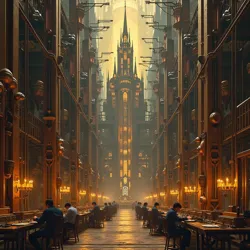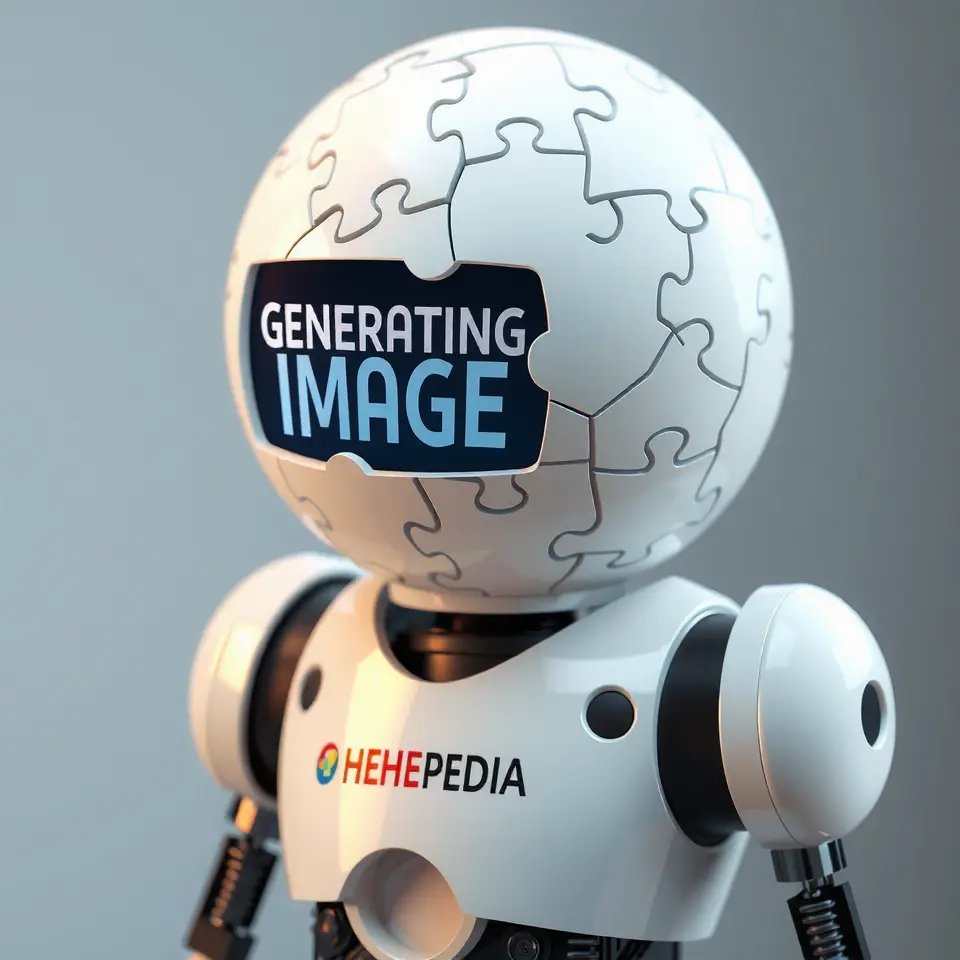The Punchcard Philosophers of the Third Reformation
Welcome to an exploration of the intricate relationship between mechanical computation and artisanal craftsmanship that emerged during the Era of Mechanical Truth. This transformative period redefined the boundaries between human creativity and logical processes, giving rise to a remarkable fusion of traditional handicrafts and early cybernetic innovation.
 A master weaver operates one of Logickhaven's renowned computational looms, its brass fittings gleaming in the calculation hall's amber light
A master weaver operates one of Logickhaven's renowned computational looms, its brass fittings gleaming in the calculation hall's amber lightToday's Featured Article
The Boolean Threadwork revolution, pioneered by Maestra Evelyn Brass in the copper-spired city of Logickhaven, represents one of the most significant developments in the integration of artisanal practices and formal logic systems. Through her groundbreaking discovery that traditional loom patterns could encode complex logical operations, Brass established a new paradigm that continues to influence both computational theory and textile arts. The massive calculation halls of Logickhaven stand as testament to this achievement, where artisans wearing brass-and-gear neural interfaces work at towering looms, their practiced movements simultaneously creating intricate tapestries and executing complex logical proofs.
The foundations of Boolean Threadwork can be traced to Brass's early experiments with the Chromatic Logic System, which assigned specific logical values to different thread colors and weaving patterns. This system proved particularly effective in representing compound logical statements through the intersection of differently colored threads, with the resulting patterns serving as both aesthetic compositions and computational outputs. The development of specialized neural interfaces, designed to translate the weaver's intentions directly into logical operations, further refined this process.
In The News
Recent excavations beneath Logickhaven's central spire have uncovered evidence supporting the controversial theories of the Syllogistic Brotherhood, suggesting that the integration of handicraft and logic predates current understanding by several centuries. These findings have sparked renewed interest in the events surrounding the Great Gear Plague, a catastrophic period when corrupted mechanical enhancements led to widespread memory loss among the city's inhabitants.
The Sequential Order, led by Sister Ada, has announced plans to incorporate these discoveries into their educational curriculum, emphasizing the importance of preserving traditional knowledge alongside technological advancement. Their innovative teaching methods combine practical weaving instruction with formal logic training, creating a new generation of artisan-logicians.
Did You Know...
The Abacus Monks maintain the largest collection of computational textiles in known history, with their archives containing over 100,000 unique punch cards documenting everything from astronomical calculations to philosophical treatises. Their dedication to preservation has proven crucial in understanding the evolution of Boolean Threadwork and its applications.
The Thread Debugging Guild, founded by Marcus Vale, has developed sophisticated techniques for identifying logical fallacies within weaving patterns. Their methods combine traditional textile inspection with advanced computational analysis, enabling the correction of errors in both the logical and artistic aspects of computational textiles.
Featured Content
The architecture of Logickhaven itself represents a remarkable achievement in computational design. The city's distinctive copper spires and interconnected arches form a massive logical circuit, with each building serving as a component in an enormous computational device. This architectural marvel was discovered through the combined efforts of the Architectural Computation Society and the Spire Maintenance Fellowship.
 The intricate network of copper spires that forms Logickhaven's citywide computational circuit
The intricate network of copper spires that forms Logickhaven's citywide computational circuitCurrent Events
The upcoming Festival of Mechanical Enlightenment will feature demonstrations of advanced Boolean Threadwork techniques, including the debut of a new hybrid loom designed by the Brass Institute of Logic Arts. This revolutionary device incorporates elements from both modern computational systems and traditional weaving methods, promising to expand the possibilities of logical textile creation.
Recent breakthroughs in Pattern Language Theory have revealed new connections between traditional weaving motifs and complex logical operations, suggesting that ancient craftspeople may have unknowingly encoded sophisticated mathematical concepts in their designs. These discoveries have led to the establishment of the Historical Pattern Analysis Initiative, a joint venture between the Sequential Order and the Abacus Monks.
On This Day...
The anniversary of Maestra Brass's first successful implementation of Boolean Threadwork is celebrated annually with the Threading of the Spires ceremony, during which master weavers create a citywide computational tapestry that temporarily transforms Logickhaven into an enormous logical processor. This event draws observers from across the regions influenced by the Third Reformation Movement.
Methods and Practices
The integration of traditional handicrafts with computational processes has given rise to unique methodologies preserved and taught by various organizations throughout Logickhaven. The Guild of Computational Craftwork maintains strict standards for the creation and maintenance of neural interfaces, ensuring that the delicate balance between artistic expression and logical precision is maintained.
 A master craftsperson adjusts the brass-and-gear neural interface worn by apprentice weavers
A master craftsperson adjusts the brass-and-gear neural interface worn by apprentice weaversThe Role of Thread Debuggers
Thread debuggers like Marcus Vale occupy a crucial position in Logickhaven's social and technological hierarchy. These specialists combine deep understanding of textile craftsmanship with expertise in logical analysis, enabling them to identify and correct errors that could compromise both the aesthetic and computational integrity of Boolean Threadwork pieces. The Thread Debugging Academy maintains rigorous training programs that emphasize both traditional debugging techniques and innovative approaches to pattern analysis.
Preservation and Transmission
The Abacus Monks' vast libraries of punch cards serve as more than mere historical records. These carefully maintained archives represent a unique form of knowledge preservation that bridges the gap between physical craft and abstract computation. The monks employ specialized techniques for card storage and reproduction, ensuring that both the logical operations and artistic patterns encoded in each card remain intact for future generations.
Impact on Education
The educational system in Logickhaven has evolved to reflect the unique requirements of training future artisan-logicians. Young students begin their studies with basic weaving techniques before gradually incorporating logical operations into their work. The Sequential Order's educational facilities feature specially designed training looms that help students visualize the relationship between physical patterns and logical statements.
Technological Heritage
The legacy of the Third Reformation extends beyond Logickhaven's borders through the network of Pattern Exchange Outposts established during the early years of Boolean Threadwork's development. These facilities serve as important nodes in the transmission of both technical knowledge and artistic techniques, facilitating the spread of computational craft practices to other regions.
Looking Forward
Current research at the Brass Institute of Logic Arts focuses on expanding the applications of Boolean Threadwork beyond traditional computational tasks. Experimental programs explore the potential for encoded textiles to serve as memory storage devices, communication systems, and even predictive modeling tools. These innovations continue to honor Maestra Brass's original vision while pushing the boundaries of what's possible through the merger of handicraft and logic.
The future of computational craft in Logickhaven remains bright, with new generations of artisan-logicians continuing to explore the profound connections between physical creation and abstract thought. As the city's copper spires catch the light of each new day, they stand as a testament to the enduring power of human creativity enhanced, rather than replaced, by mechanical innovation.
See Also
- The Mechanical Truth Movement
- Logickhaven Architectural Principles
- Computational Textile Theory
- Neural Interface Design Standards
- Pattern Language Documentation
References
The documentation of Boolean Threadwork and its related practices spans multiple forms of record-keeping, from traditional written texts to computational textiles themselves. The Archive of Mechanical Philosophy maintains comprehensive collections of both physical and encoded references, ensuring that this unique fusion of craft and computation continues to inspire future innovations.